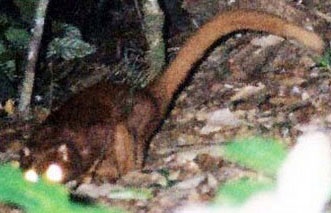In search of Bigfoot, scientists may uncover unknown biodiversity in Malaysia
Rhett A. Butler, mongabay.com
February 1, 2006
Malaysian scientists are scouring the rainforests of Johor state in search
of the legendary ape-man Bigfoot, supposedly sighted late last
year. But they are more likely to encounter some less fantastic but
unique creatures that dwell in these still unexplored
ecosystems.
In recent years a number of new and conspicuous animals have
been discovered in the forests of South and Southeast Asia,
including 361 new species in Borneo over the past decade and 43 new
species of vertebrates in Sri Lanka. Just last year, scientists with
the World Wildlife Fund (WWF) captured on film what may be a new species of
mammal in the rainforests of Kalimantan in Indonesian Borneo. The
fox-like creature is apparently unknown even to local hunters.
Such is not the case with another species discovered last year. The
kha-nyou, a bizarre long-whiskered rodent, was first described by
Wildlife Conservation Society (WCS) scientists after it was found on a
table at a hunter’s market in central Laos. The animal has since been
classified in its own taxonomic family.
 Frontal view of mysterious fox-like animal found in the rainforests of Borneo last year by WWF scientists. © Stephan Wulffraat / WWF |
While most experts agree that the likelihood is remote of finding the “Bigfoot” beast
Malaysian tribal people call hantu jarang gigi, the country’s efforts to ascertain the existence of such a creature are not the first time a government in the region has
acted on behalf of a cryptozoological entity. Bhutan created Sakteng
Wildlife Sanctuary—650 square kilometers of temperate
rhododendron and pine forests in the eastern part of the
country—specifically to protect the habitat of the yeti, better
known as “Bigfoot” or “Sasquatch” in other parts of the world. To
date the yeti has proved elusive, but Bhutan as a whole is home to 29
other species of mammals and more than 625 kinds of birds. Besides
“Bigfoot,” Malaysia has had reported sightings of another mysterious
“cryptid,” the orang pendek, which is said to be an unclassified
species of primate similar to the orangutan but standing only two and a
half to five feet in height (thus there would be no confusing the
orang pendek with the alleged “Bigfoot” which is said to stand nine
feet tall). Periodic sightings of the orang pendek date back to the
Victorian era but expeditions to find the species have turned up no
conclusive evidence.
 Orangutan in Sumatra. Orangutans are increasingly threatened due to habitat loss and poaching for the pet trade. WWF estimates that 3 percent of the world’s population of these apes are lost to poachers each year. Photo by Jen Caldwell. Background on the recent Bigfoot hysteria Bigfoot has been big news in Malaysia since November when three day laborers claimed they saw a family of Bigfoot on a riverbank in Kota Tinggi reserve. The witnesses ran but later returned with an “educated colleague” to photograph the footprints which measured 45cm – equivalent to a man’s size 20 shoe. |
The existence of such creatures is very much in doubt, and hopes of
finding the unknown are fading due to widespread habitat loss across
much of Asia. The situation is especially urgent in Malaysia, where
deforestation rates have jumped 86 percent since the close of the 1990s as a
result of forest degradation and clearing for oil palm, logging, and
other forms of development. With primary forest covering around 10
percent of the country, the chances of finding Bigfoot or other
creatures is diminishing fast.
“Skeptics might say that if we are still discovering such amazing new
animals, why are people worried about wildlife loss,” said Dr. Robert
Timmins, a WCS researcher, at the time of his Lao rodent discovery.
“But of course it is an indication of how little we know, and a
window onto what we could be losing without ever knowing.”
For more information on current research in Malaysia’s rainforests, take a look at the
Center for Tropical Forest Science (CTFS) Asia, the WCS-Malaysia Program, and the WWF-Malaysia.